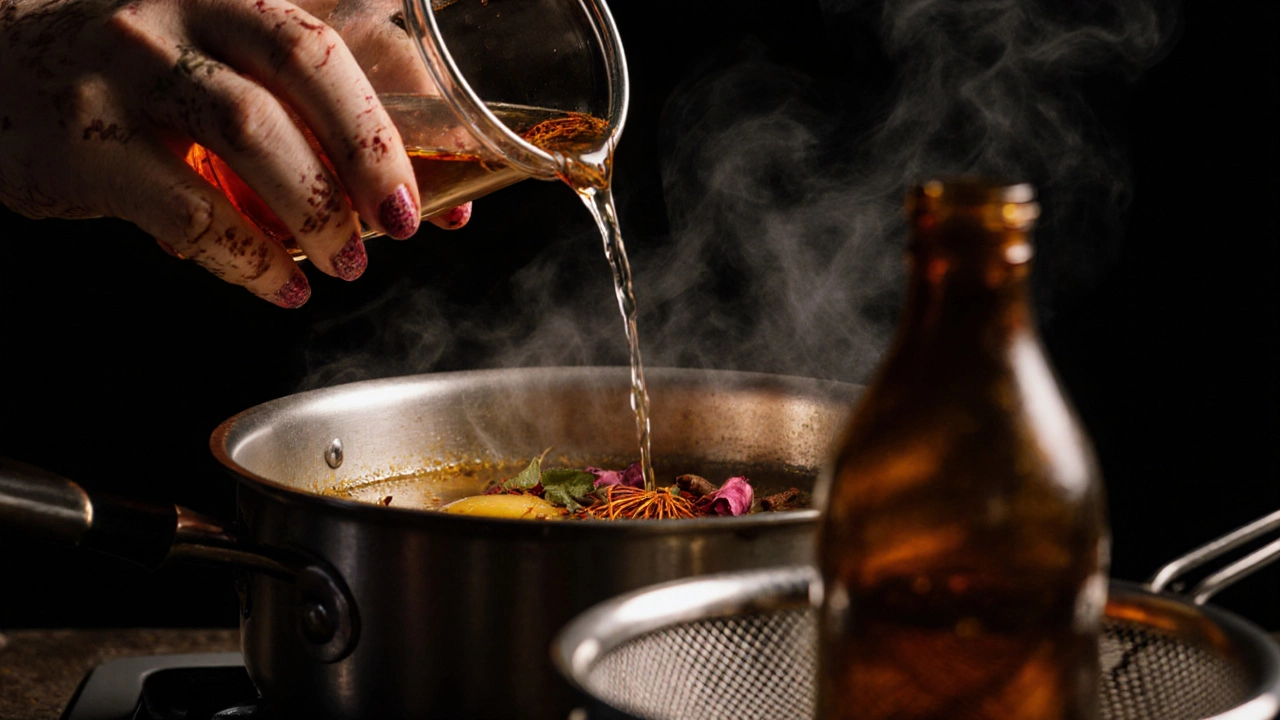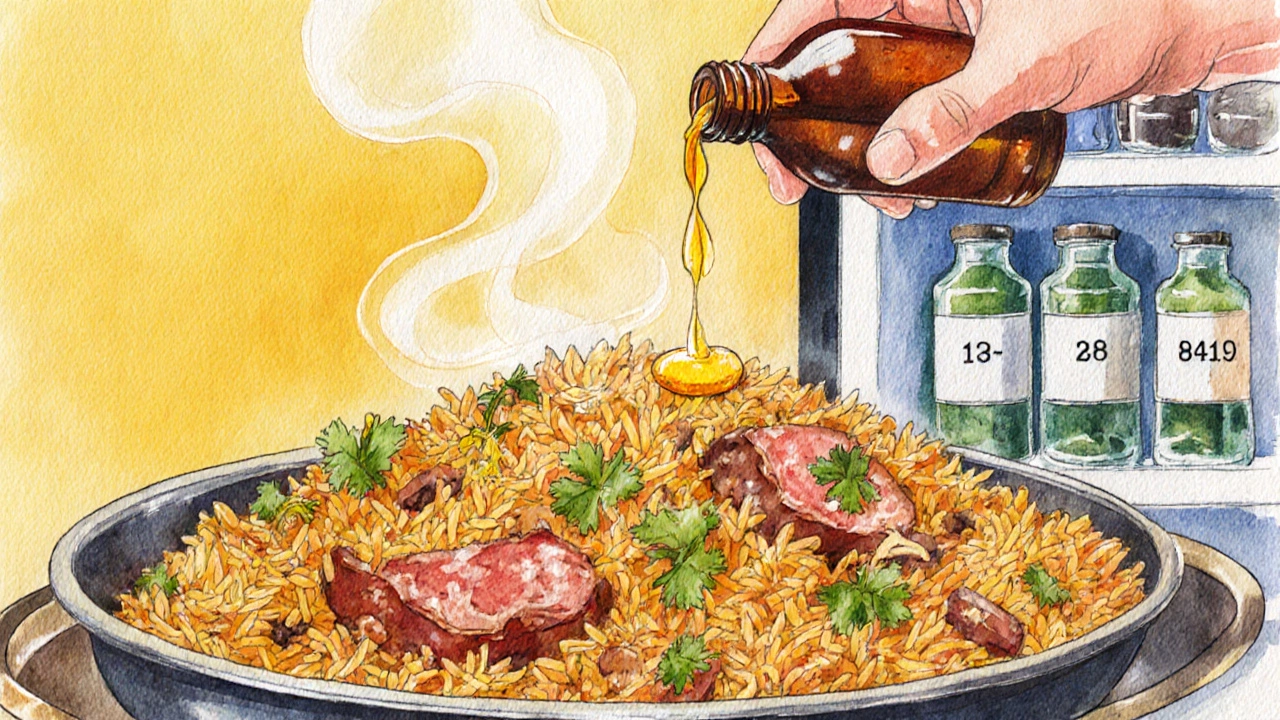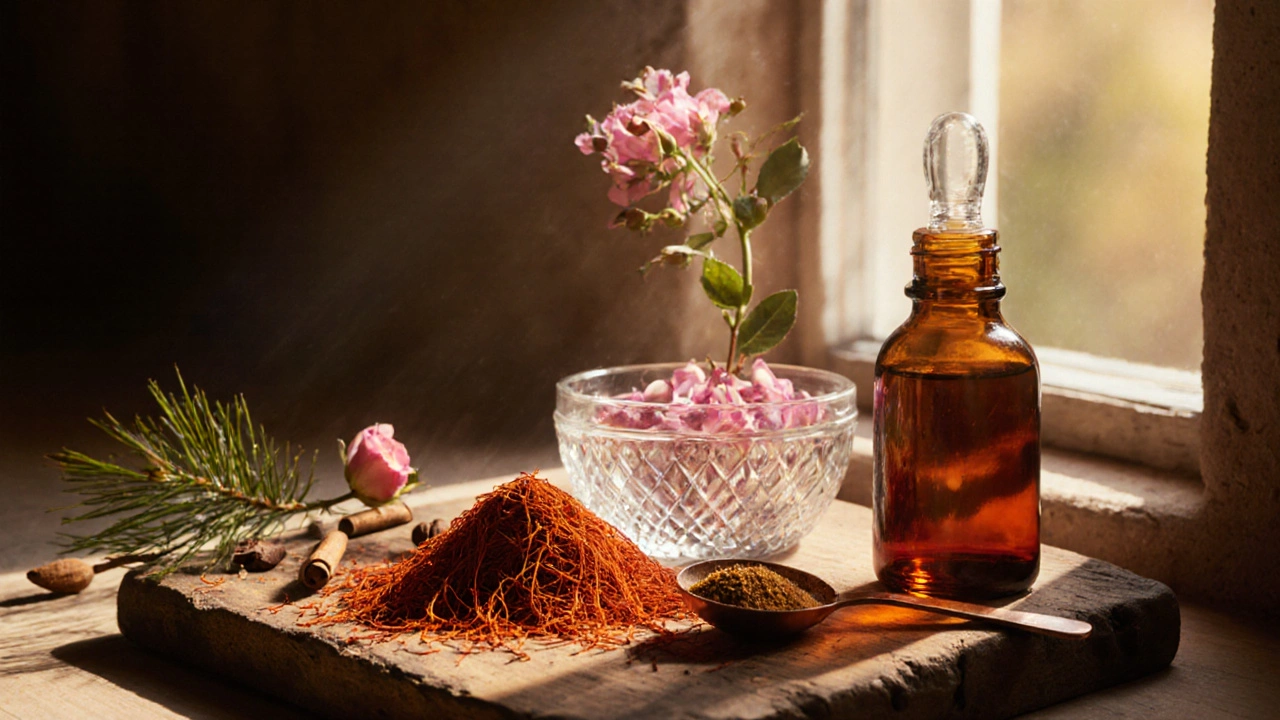Biryani Essence Calculator
Essence Composition:
Recommended Essence Usage:
Store in an airtight glass container away from light. Refrigerated, it lasts 2–3 months.
Key Takeaways
- Traditional biryani relies on a handful of aromatic essences: saffron, rose water, and kewra water.
- Commercial biryani essence blends these aromatics with a pinch of garam masala for convenience.
- You can create a DIY essence by steeping spices in ghee or oil and adding a splash of floral water.
- Store essences in airtight glass containers away from light to preserve flavor for months.
- Avoid over‑using essences - a little goes a long way and prevents a soapy taste.
What Exactly Is "Biryani Essence"?
When a recipe calls for biryani essence, it’s referring to a concentrated aromatic blend that mimics the perfume of a classic slow‑cooked biryani. Biryani essence is a liquid or paste made from saffron, rose water, kewra water, and a touch of ground spices, designed to infuse rice and meat with a rich, floral aroma. In South Asian kitchens the term often overlaps with "biryani masala," but the essence is usually more fluid and used in smaller quantities, like a flavor‑boosting shortcut.
Core Aromatics Behind the Essence
The magic comes from three traditional aromatics. Each has its own chemistry and contributes a distinct note.
- Saffron is the dried stigma of Crocus sativus, delivering a golden hue and a subtle honey‑like flavor. One gram can flavor a kilogram of rice.
- Rose water is distilled from fresh rose petals; it adds a gentle floral sweetness without any vegetal taste. Use about 1-2 teaspoons per pot.
- Kewra water is extracted from the male inflorescences of the screw‑pine; its aroma is earthy, woody, and slightly citrusy. A splash (½ teaspoon) balances the rose’s softness.
These three are often blended with a pinch of ground cardamom, cloves, and bay leaf, creating the signature bouquet of a good biryani.

Commercial Biryani Essence vs. Homemade Mix
Store‑bought essence is convenient: manufacturers dissolve saffron, rose, and kewra extracts in water or alcohol, then add a pre‑measured spice mix. The label usually lists "biryani masala, saffron extract, rose water, kewra essence, salt". While the taste is decent, you lose control over freshness and can end up with a slightly synthetic aftertaste.
Making your own essence gives you two big advantages:
- Flavor purity - fresh saffron threads release volatile compounds that survive only a few weeks in a sealed bottle.
- Cost efficiency - a gram of saffron costs $10‑$15, but a small batch of homemade essence can stretch that amount across several biryanis.
Below is a quick side‑by‑side of the two options.
| Attribute | Commercial Essence | Homemade Essence |
|---|---|---|
| Shelf life | 6-12 months (preservatives) | 2-3 months (refrigerated) |
| Flavor intensity | Medium, consistent | High, fresh |
| Cost per litre | $30‑$40 | $12‑$18 (DIY) |
| Control over ingredients | Low | Full |
| Typical usage | 1-2 tsp per pot | 1 tsp (adjustable) |
Step‑by‑Step: Crafting Your Own Biryani Essence
Gather the following items. All are pantry staples for an avid home cook.
- Ghee clarified butter that acts as a flavor carrier - ½ cup
- Saffron threads - 0.5g (about a pinch)
- Rose water - 2Tbsp
- Kewra water - ½tsp
- Ground cardamom, cloves, bay leaf - ¼tsp each
- Fine‑mesh strainer and a clean glass bottle (preferably amber)
- Warm the ghee in a small saucepan over low heat. You want it liquid but not smoking.
- Add the saffron threads and let them steep for 3‑4minutes. The ghee will turn a deep amber and absorb the saffron’s aroma.
- Stir in the ground cardamom, cloves, and bay leaf. Cook for another minute, allowing the spices to bloom.
- Remove the pan from heat and pour in the rose water and kewra water. Mix gently; the liquids will emulsify with the warm ghee.
- Let the mixture cool to room temperature, then strain through the fine mesh into your bottle. Seal tightly and store in the refrigerator.
The resulting essence has a silky mouthfeel, bright floral notes, and a lingering saffron hue. Use 1tsp per kilogram of rice, adjusting to taste.
How to Incorporate Essence into Different Biryani Styles
Whether you’re cooking Hyderabadi chicken biryani, Kolkata vegetable biryani, or a quick stovetop version, the essence fits into the cooking process at a specific point.
- Layered (dum) biryani: Drizzle the essence over the rice layer just before sealing the pot. The steam will carry the aroma throughout.
- One‑pot biryani: Add the essence after the rice has absorbed most of the broth, stirring gently to distribute.
- Vegetarian biryani: Combine the essence with a splash of yogurt or coconut milk before mixing with vegetables for a richer mouthfeel.
Remember, the essence is potent - start with the recommended amount and taste before adding more.

Common Pitfalls and How to Avoid Them
Even seasoned cooks can mishandle essences. Here are the usual mistakes and quick fixes.
- Using too much: The floral notes can become cloying, turning the biryani "soapy". Counteract with an extra pinch of salt or a squeeze of lemon.
- Adding essence too early: Heat destroys volatile compounds. Add it at the end of cooking or during the final steam stage.
- Storing in metal containers: Metal reacts with saffron and rose water, dulling flavor. Always use glass.
- Reusing stale essence: After a few weeks, oxidation reduces aroma. Label your bottle with a date and discard after three months.
Frequently Asked Questions
Can I substitute rose water with orange blossom water?
Yes. Orange blossom water offers a similar floral sweetness but with a citrus edge. Use the same quantity and adjust other spices if needed.
Is kewra water essential for a good biryani?
Kewra adds a distinctive earthy note that many traditional recipes rely on, but if you can’t find it, a tiny dash of vanilla extract or a pinch of nutmeg can mimic the depth.
How long does homemade essence stay fresh?
Stored in a sealed amber glass bottle in the fridge, it remains aromatic for about 2-3months. Once the color fades or the scent dulls, it’s time to make a new batch.
Do I need to rinse saffron before using it in the essence?
No. Rinse can wash away the volatile oils. Just crush the threads gently before steeping in warm ghee.
Can I make a vegan biryani essence?
Absolutely. Replace ghee with a neutral oil like sunflower or grapeseed, and follow the same steps. The essence will still carry the floral and spice notes.
Next Steps: Elevate Your Biryani Game
Now that you understand the role of essences, try these experiments:
- Make a batch of essence, freeze it in ice‑cube trays, and pop a cube into any biryani in the future.
- Blend a tiny amount of smoked paprika into the essence for a subtle smoky twist.
- Swap ghee for coconut oil in the DIY recipe for a tropical flavor profile that pairs well with shrimp biryani.
Each tweak adds a personal stamp while respecting the core aromatic foundation of a classic biryani.
